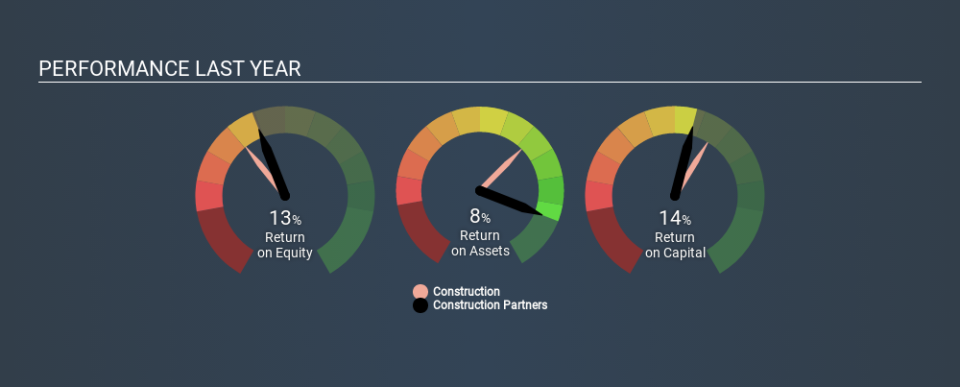A Close Look At Construction Partners, Inc.’s (NASDAQ:ROAD) 14% ROCE

Today we'll look at Construction Partners, Inc. (NASDAQ:ROAD) and reflect on its potential as an investment. To be precise, we'll consider its Return On Capital Employed (ROCE), as that will inform our view of the quality of the business.
First, we'll go over how we calculate ROCE. Then we'll compare its ROCE to similar companies. And finally, we'll look at how its current liabilities are impacting its ROCE.
Return On Capital Employed (ROCE): What is it?
ROCE measures the amount of pre-tax profits a company can generate from the capital employed in its business. In general, businesses with a higher ROCE are usually better quality. Ultimately, it is a useful but imperfect metric. Author Edwin Whiting says to be careful when comparing the ROCE of different businesses, since 'No two businesses are exactly alike.
How Do You Calculate Return On Capital Employed?
The formula for calculating the return on capital employed is:
Return on Capital Employed = Earnings Before Interest and Tax (EBIT) ÷ (Total Assets - Current Liabilities)
Or for Construction Partners:
0.14 = US$55m ÷ (US$532m - US$128m) (Based on the trailing twelve months to September 2019.)
Therefore, Construction Partners has an ROCE of 14%.
See our latest analysis for Construction Partners
Is Construction Partners's ROCE Good?
ROCE can be useful when making comparisons, such as between similar companies. Using our data, we find that Construction Partners's ROCE is meaningfully better than the 11% average in the Construction industry. We consider this a positive sign, because it suggests it uses capital more efficiently than similar companies. Independently of how Construction Partners compares to its industry, its ROCE in absolute terms appears decent, and the company may be worthy of closer investigation.
You can see in the image below how Construction Partners's ROCE compares to its industry. Click to see more on past growth.
It is important to remember that ROCE shows past performance, and is not necessarily predictive. ROCE can be misleading for companies in cyclical industries, with returns looking impressive during the boom times, but very weak during the busts. ROCE is only a point-in-time measure. Since the future is so important for investors, you should check out our free report on analyst forecasts for Construction Partners.
How Construction Partners's Current Liabilities Impact Its ROCE
Current liabilities are short term bills and invoices that need to be paid in 12 months or less. The ROCE equation subtracts current liabilities from capital employed, so a company with a lot of current liabilities appears to have less capital employed, and a higher ROCE than otherwise. To counter this, investors can check if a company has high current liabilities relative to total assets.
Construction Partners has total liabilities of US$128m and total assets of US$532m. Therefore its current liabilities are equivalent to approximately 24% of its total assets. Low current liabilities are not boosting the ROCE too much.
Our Take On Construction Partners's ROCE
With that in mind, Construction Partners's ROCE appears pretty good. Construction Partners looks strong on this analysis, but there are plenty of other companies that could be a good opportunity . Here is a free list of companies growing earnings rapidly.
If you like to buy stocks alongside management, then you might just love this free list of companies. (Hint: insiders have been buying them).
If you spot an error that warrants correction, please contact the editor at editorial-team@simplywallst.com. This article by Simply Wall St is general in nature. It does not constitute a recommendation to buy or sell any stock, and does not take account of your objectives, or your financial situation. Simply Wall St has no position in the stocks mentioned.
We aim to bring you long-term focused research analysis driven by fundamental data. Note that our analysis may not factor in the latest price-sensitive company announcements or qualitative material. Thank you for reading.

